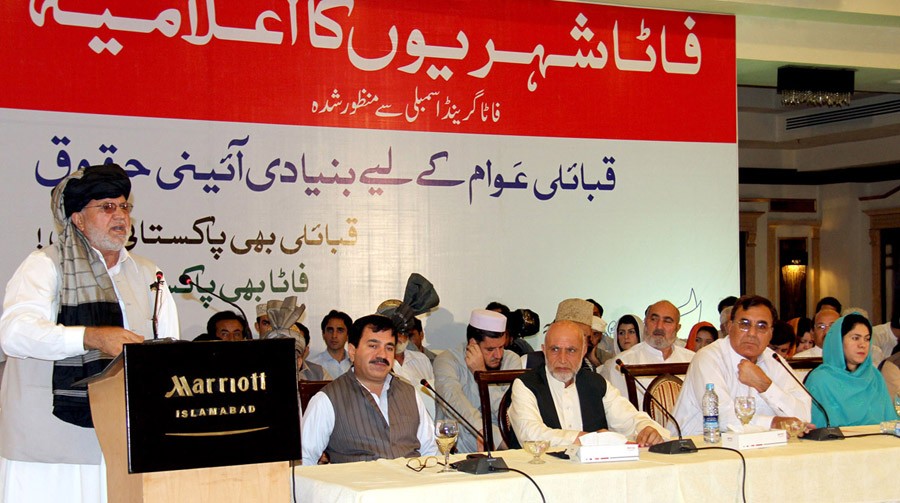
While PkMAP and ANP play power politics with each other, the fate of FATA’s merger is still undecided

The Pakhtunkhwa Milli Awami Party (PkMAP’s) jirga on the Federally Administered Tribal Areas (FATA) reforms, convened in Islamabad at the end of October 2016, underscored that the controversy around mainstreaming the tribal areas was not yet over. PkMAP claims to have a vision of a united province for all Pashtuns of Pakistan, but the party’s opposition to FATA’s merger with Khyber Pakhtunkhwa appears paradoxical and leaves one bewildered.
Can we make some sense of the apparent irony?
Understanding PkMAP’s nomenclature is necessary in order to comprehend its stance on FATA and Pashtun-populated areas at large. In Balochistan, ‘Southern Pashtunkhwa’ refers to Pashtun-populated areas that were historically known as British Balochistan. Khyber Pakhtunkhwa is called ‘Northern Pashtunkhwa’ and FATA is billed ‘Central Pashtunkhwa’. Combined with Attock and Mianwali in Punjab, the merger of southern and northern Pashtunkhwa into a single federating unit, by the name of either Pashtunkhwa or Afghania or Pashtunistan, is PkMAP’s vision of Pashtun integrity within Pakistan. Nevertheless, ironic as it may be, PkMAP does not envision FATA as part of any united province for the Pashtuns in future.
The party claims that if we are to progress from history, our future must be better than our past with regards to achieving autonomy. The predominantly Pashtun-populated areas of Balochistan, and Attock and Mianwali in Punjab are ‘oppressed’ parts of Pashtunkhwa, called Mahkoom Pashtunkhwa. Northern Pashtunkhwa, (present-day Khyber Pakhtunkhwa), being a federating unit and Pashtun majority province, is comparatively free.
From PkMAP’s perspective, FATA is even freer. The party believes that the seven tribal areas and their six adjoining frontier regions, collectively called FATA, are more autonomous than Khyber Pakhtunkhwa. The disposal of criminal and civil cases partly in accordance with Pashtun culture, as enshrined in Frontier Crimes Regulation (FCR), rather than Pakistan Penal Code (PPC), the role of jirga as the forum for conflict resolution rather than the operation of regular judiciary and the influential role of tribal elders, militating against the state’s bureaucracy, all give a more autonomous and freer status to FATA in comparison to Khyber Pakhtunkhwa.
So, the integration of FATA with Khyber Pakhtunkhwa, the argument runs, is a regression: from freer to free.
From the party’s perspective, if any changes were to be brought about in the sociopolitical and administrative systems of FATA, they should guarantee progression. FATA should be entitled to a freer status than it enjoys now. The ‘Elected Council for FATA’, reminiscent of the Azad Kashmir status, is PkMAP’s role model for FATA’s future. It promises the tribal region its own prime minister, president and, in short, the paraphernalia of a state within a state.
The party’s views also appear revisionist. The incorporation of FATA into Khyber Pakhtunkhwa, a federating unit, is against the historical essence of the tribal hinterland as part of the British sphere of influence vis-à-vis the Afghan state than an integral part of the then British India and, by implication, today’s Pakistan.
This leads us to ask if PkMAP’s position is irredentist. The answer lies in the importance of politics within Pakistan than without it. To understand this better, an old puzzle is worth revisiting: will Khan Shaheed’s Gulistan or Bacha Khan’s Charsadda be the leading centre of Pashtun nationalism? Placing FATA’s reforms against the backdrop of the 2018 elections may solve the old riddle.
With the next national election around the corner, PkMAP’s support for the ‘Elected Council of FATA’ is meant to portray the Awami National Party’s (ANP) support for FATA’s merger with Khyber Pakhtunkhwa as a travesty of Pashtun nationalism. For one, the ANP is toeing the establishment’s line. PkMAP says that bringing FATA within the ambit of Pakistan’s federation is not possible without the tacit approval of the security establishment. PkMAP’s designation of FATA as a separate entity, rather than supporting its integration with Khyber Pakhtunkhwa is meant to discredit ANP in the eyes of ideological voters. ANP’s support for the merger is portrayed as an acceptance and endorsement of the Durand Line agreement.
The need for opposing the merger that ANP supports might not have been so desperate had it not been for the last ditch effort within PkMAP to bridge intra-party division, and compensate for its poor performance in Balochistan before the incoming elections. For the ordinary citizen, the only visible change in Balochistan’s Pashtun belt, and the province at large, is the comparative improvement in law, order and security -- which in no small measure is owed to National Action Plan post the attack on the Army Public School in Peshawar. The PkMAP aims to appease the sidelined ideologues on the one hand, and carve a vote bank for the party in the tribal areas and Khyber Pakhtunkhwa on the other.
In nutshell, the gimmickry of power politics between PkMAP and ANP is almost exclusively directed against each rather than the central government.
In conclusion, the question one asks is what should the central government do? The most important lesson we can derive from the last 15 years of instability is that FATA holds the key to peace in Pakistan. The socioeconomic, administrative and political mainstreaming of the tribal belt is vital for enduring peace on the frontier, and the country at large. The incorporation of FATA into Khyber Pakhtunkhwa, as proposed by the government-sponsored FATA Reforms Committee, may not be the best option though it is the very first, and the most pragmatic, step in the right direction.